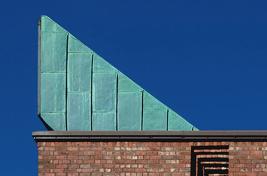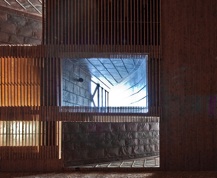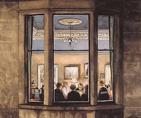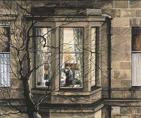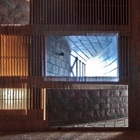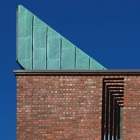St Bride’s East Kilbride



Our Building
"Gillespie, Kidd & Coia: Architecture 1956-1987" celebrated the work of one of Scotland's most heralded twentieth century architecture practices. It comprised a major exhibition, book, website, education and outreach programme and the conservation and cataloguing of GKC's archive which was gifted to The Glasgow School of Art in 2001.
At the centre of the book and exhibition, indeed, on the cover of the book itself, is the building which is St Bride's Church; widely regarded as one of the finest pieces of post war ecclesiastical architecture in Scotland.
Perhaps this book and exhibition can help bring us to a greater understanding of the building in which we come together in communion each week.
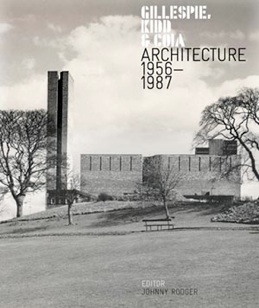

Language
Architects Andy MacMillan and Isi Metzstein designed St Bride's.
Here, in a clip from "Slide In" (part of the exhibition) , they discuss how aspects of Scotland's architectural heritage, notably the work of Charles Rennie Mackintosh and the great Scottish castles, influenced their desire to use "heavy masonry" to play with light.
We begin to catch glimpses of how these influences played a pivotal role in the design of St Bride's.

Towards the end of this 3D animation, which provides some highly original perspectives, there's a walk up the steps on Whitemoss Avenue into the piazza.
This will be a familiar walk to many but the animation does compel us to look up and get a sense of the almost medieval feeling of the building: a view which one might be tempted to compare with that of an older building in the parish, Mains Castle.
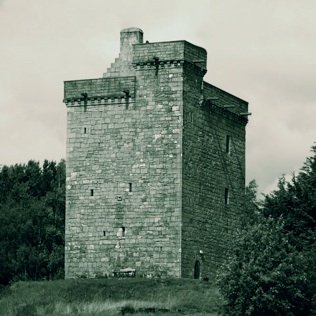
It's doubtful that Andy and Isi would have seen Mains Castle prior to working on St Bride's. Nevertheless, the castle speaks in Scotland's native architectural language and has features which MacMillan and Metzstein have incorporated into their own modern vocabulary.
An obvious example would be how the deep slotted windows of the castle find an echo in the interior of the great east wall of the church.
There are subtler references to what, in the nineteenth century, became the Scottish Baronial style. This style influenced architects such as James MacLaren (Fortingal, Glen Lyon) and, later, Mackintosh. The "crowstep gable" at the top of the castle finds a modern mirror in the entrance in the piazza.
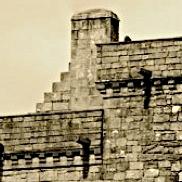
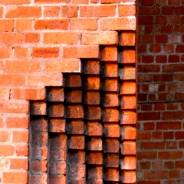
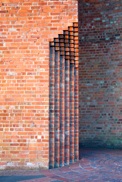
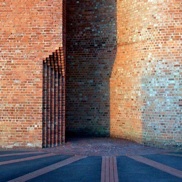

Light
Andy and Isi designed St Paul's, Glenrothes, some years before St Bride's.
In this short clip from the exhibition, Andy describes the thought processes they used in church design.
Particular attention is paid to the use of light and the way in which the faithful enter the building.
The interior of St Bride's has amongst the highest walls and longest span of any church by MacMillan and Metzstein. The lighting of the sanctuary and (now unused) pulpit required particular ingenuity: Andy and Isi came up with the idea of "light cannons" to focus attention on the altar and pulpit.
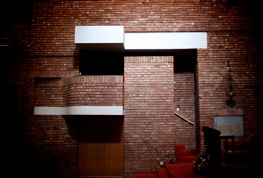
Interviewed on Radio Scotland twenty five years ago, in a programme which celebrated the work of Charles Rennie Mackintosh, Andy spoke of the technique of pushing out beyond the building's envelope in order to capture more space and more light.
In Scotland, we're used to seeing this in the bay windows of Victorian tenements. Drawing on this tradition, Andy and Isi allowed the altar to push through the south wall. This created an intimate niche in a comparatively vast interior, helping to bring the congregation's attention to rest on the Tabernacle and the Blessed Sacrament.
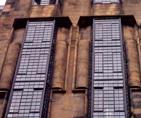
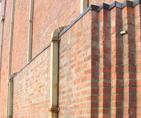
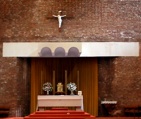

Place
Enjoy Andy and Isi's friendly spat as they use the Scottish Parliament campus and a traditional stone cottage to share ideas on how buildings contribute to the sense of place.
They make reference to how landmark buildings, such as Sydney Opera House, become the most potent symbols with which a town or landscape is associated.
At the end of the discussion about the cottage, Andy talks about how a building which is understood by its builders - because this type of building has been built for hundreds of years - sits very well in the landscape. This idea contrasts with, but doesn't contradict, Andy's earlier idea of what buildings we think of when we imagine great cities. Extravagant buildings like Sydney Opera House, the Sagrada Familia, St Paul's Cathedral and St Peter's are iconic structures which have come to symbolise the cities which they occupy.
Where St Peter's and St Paul's draw on the history of classical architecture, the Sagrada Familia echos gothic features in Antoni Gaudi's energetic, if idiosyncratic style. Whatever their differences in style, visitors flock to these buildings: some to look, some to learn, some to immerse themselves in each building's sacred purposes.
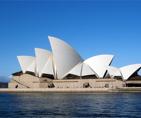
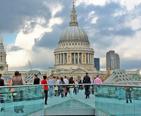
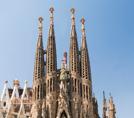
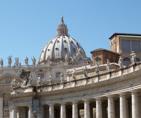
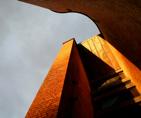
Listening to Andy and Isi and considering, once more, the long and rich history of the church in the area of East Kilbride, it becomes apparent that we too are in possession of a unique building, born of its own particular time and place. A building which reflects an architectural heritage from Mackintosh back to the Scottish medieval castles. In his book, "The Aesthetics of Architecture", the philosopher Roger Scruton talks of "the impulse to which we owe most of the fine architecture we have inherited (as being) an impulse founded in the sense of place - the desire to mark a sacred spot... to build a monument, church or landmark, to claim possession or dominion of the land."
Even shorn of its campanile, St Bride's insists on being noticed, on being regarded, on being talked about and endlessly argued over from its vantage point above Avondale. An insistence which we now find grabbing the attention of academics around the world.
Architecture students come to St Bride's on study visits from schools all over Europe. Increasingly, their tutors tell them to seek out this often neglected masterpiece. And yet, if it's only architecture students who come to study the building, to enjoy its spaces and forms, to learn of its roots and legacies, then perhaps we're still too early in the history of St Bride's - as a building - to really appreciate the true nature of the building in our custody.
East Kilbride is a New Town, a modern town and still very much a young town. The tradition of the local church, however, can trace its roots to the Celtic monastic cell which gave its name to Kilbride and which was situated less than a hundred yards from the village's Old Parish Church. In an age of increased secularism, an age where many people have, consciously or unconsciously, discarded ideas of God - but still look for something to fill the void - the parish of St Bride's finds itself in possession of a unique opportunity.
Here is a building, a modern building, which consciously and unashamedly proclaims its purpose and the history of its roots: a building which could not have taken its form without that purpose and history. At the start of the twenty first century, the parish of St Bride's is the keeper of an idea, an icon, a symbol planted on the side of a hill. Building for God, an agency of hope; an agency of reconciliation; an agency of love - a gift we have received and must cherish in order to share and pass on.
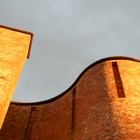
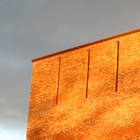
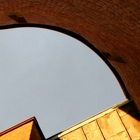
Acknowledgements
Colour photographs of St Bride's are courtesy of:
Fr Tom Devlin
Jason Brown, Principal, abbozzo architects
Jon-Marc Creaney
Videos and animation are courtesy of Gillespie, Kidd & Coia: Architecture 1956-1987.
Details of "Kissing" and "The Gathering" are courtesy of Avril Paton.
Gillespie, Kidd & Coia: Architecture 1956-1987 celebrated the work of one of Scotland's most heralded 20th century architecture practices. It comprised a major exhibition, book, website, education and outreach programme and the conservation and cataloguing of the archive gifted to The Glasgow School of Art in 2001.
The project was created by
The Lighthouse in partnership with
The Glasgow School of Art and the
Royal Commission on the Ancient and Historical Monuments of Scotland and was funded by the
Heritage Lottery Fund,
The Scottish Government,
Historic Scotland,
Royal Incorporation of Architects in Scotland,
The Cragnish Trust and
The Ernest Cook Trust.
Every effort has been made to trace and contact the copyright holders of the photographs reproduced on this website.
Any omissions are entirely unintentional and the details should be addressed to SBEK.


